Hello and welcome to a new chapter of guide theMediterranean diet for health and fitness, and in which we'll be taking a long, hard look at the thorny subject of bioavailability. proteins.
In this content reserved for Blooness members, we will answer the following question: in which foods can you find the most bio-available proteins for the body, but at the same time the healthiest ones, weight loss and longevity ?
This content is part of the guide Blooness, the guide to the ideal human diet, the summary of which you can find here 🌱🥑
So here we list the various indicators that measure bioavailability foods that contain protein, and discover which foods rank at the topwhile interpreting the various results.
As a reminder, feeding Mediterraneanidentified by science as one of the most effective ways of eating for a long, healthy life and maintaining a healthy weightincludes proteins such as fish, white meat, vegetables pulses and quality dairy products.
French-speaking subscribers will receive the newsletter in French, and all others will receive an English version.
Introduction available to all in podcast format:
Feeding low-carb alsoa fortiori, since it is composed of fats and proteins. The question here is to understand in which specific foods, and in which context, we can find quality proteins that can be efficiently absorbed and used by the body.
All these questions about protein intake are intended as food for thought, to be adapted to each individual case, and by no means as recommendations, simply a synthesis of information we're going to try to decipher.
The idea here is to popularize content content available on the Internet, which is sometimes dense and rather complicated, in order to democratize it, so that everyone can make the most judicious choices according to their own situation, and thus adapt their diet by testing what works well, and what works less well.
This major section on protein bioavailability is divided into four sub-chaptersfor reasons of clarity and ease of reading. This will make it simpler for readers (and listeners, since the content will also be available in podcast format) to learn at your own pacewithout having to deal with too much information all at once.
As a reminder, podcast format allows you to listen and learn intuitively by listening to the audio track, sometimes doing another activity at the same time, and if you've listened to the audio format, the text format allows you to come back to specific points and go into greater depth..
All this content is part of the Blooness guidethe ideal food guideand are aimed at a public not necessarily well-informed about nutrition issues. So don't worry if you don't know anything about ithere, the idea is to learn at your own pacechapter by chapter, and become increasingly aware of the issue of food, in order to develop your own way of eatingIt's the most pleasurable and at the same time the most effective for longevity, good health and maintaining a healthy weight.
The aim of all this content is to popularize the information available and make it understandable to as many people as possible. In the case we're interested in here, namely protein bioavailability, this initially complicated content will be unravelled to make it as simple as possible, with the aim of making dietary choices much more effective when it comes to guaranteeing one's protein intake. protein.
The idea is not to memorize the various indicators, but simply to have an overview of what each bioavailability indicator tells us about proteinsto make the best food choiceThe best time to eat, according to mealtimes and seasons.
As a reminder, protein is the cornerstone of the human diet, and it is in fixing the protein intake that the most common errors. That's why it was important to go into detail on the subject of protein bioavailability, not so that we don't end up exclusively consuming certain foods to the detriment of others, on the pretext that they are the most easily assimilated, but at least prioritize certain more efficient foods on a relatively frequent basisto ensure the best possible tissue regeneration, the best possible health, and optimal longevity.
So if you're ready to revolutionize your diet and give your body the best possible fuel to be in the best possible healthIt's in the rest of this content (and of course in all the others to which you have free access as a premium member) that you're likely to find answers to your questions...
Here's what we'll learn in this exclusively reserved premium content to Blooness members :
- What is protein bioavailability?
- What are the different protein bioavailability indicators?
- The list of the most bioavailable foods for each of these indicators.
This content is part of the set of chapters dedicated to proteins in the diet lowcarb and Mediterranean, and you can find the summary here.
As a reminder, this and all other content is only available to Blooness premium members, for subscription details, click on this link.
Bioavailability of protein sources
Before getting to the heart of the matter and discovering precisely in which foods we can find quality proteins without damaging our healthWe'll start with a quick reminder of a point we've already made in the previous chapter, which dealt with mild protein deficiencies that affect most individuals, especially in affluent households where meat consumption seems to be declining.
We had seen that many people are unknowingly slightly protein-deficientAnd that most of their little daily worries, such as skin problems, pale complexion, energy, vitality, libido, hair quality or difficulty gaining muscle mass, could be partly resolved by a slight increase in their protein intake. Not by falling into the other trap of eating too much red meat, sometimes of mediocre quality, but simply by increasing their intake.
The reasons why protein is being shunned could well be as follows. First of all, protein-rich foods are often the most expensive. Secondly, they've had a bad press over the past ten years. And finally, they are paradoxically unattractive. in the collective imagination, as opposed to foods dominated by carbohydrates and lipids. The perfect illustration of this is the burger, which without the bun and fries loses much of its appeal in the eyes of consumers.
Protein foods are therefore not necessarily prioritized for purchase, and sometimes not even by the sporting public, except of course among hardened body-builders.
That about sums it up the issues raised in the previous chapterTo introduce this new content, we will recall what we explained earlier, namely that some protein foods are more bioavailable than othersand foods with a higher tissue conversion rate than others.
And to sum it all up very simply, we saw that animal proteins were generally more easily assimilated by the body than plant proteinsand that they had a more complete combination of amino acids than plant-based protein foods.
This doesn't mean we should banish plant-based protein foods.but good to know when we want to compose our plates with a view to achieving certain objectives, including the maintenance of muscle, bone and tendon mass, but also things that at first glance seem more superficial but are in fact not, as they reflect the health of tissues, intestinal health and general health, such as for example better skin, stronger hair, a more radiant complexion, and better tissue quality in general.
In practice, since we're not talking about a single protein diet, which would run counter to culinary pleasure and the precautionary principle to which we're all attached, and which consists of taking advantage of the diversity of what nature can provide us with seasonally, while listening to our bodies to avoid foods we might not tolerate, we can imagine, for example meals combining plant and animal proteins.
The mix of meat and plant proteins reduces the financial cost of the plate, while providing sufficient protein and taking advantage of the benefits that plant proteins can bring (particularly in terms of micronutrients and bacteria for the intestinal microbiota).
For flexitarians and vegetarians, a combination of the following is also possible different vegetable protein sources to cover all our amino acid needsand this is something we saw in the chapter dedicated to the complementarity of plant proteins.
Then, still in the same chapter, we quickly skimmed over the fact that the protein foods most beneficial for tissues (skin, hair, nails, muscles, organs), i.e. foods that are most easily converted into human tissuewould be eggs (with yolk)followed by meats and fish. We could very well stop here, but we'll see in this chapter, and in the three that follow, that there are a few subtleties to be added, and that there are contexts during which it's a good idea to consume a particular protein food.
In any case, not all proteins are created equal, and their combination with lipidsor the carbohydratesor other more or less beneficial nutrients, are also at stake in terms of assimilation and utilization by the body.
In order to objectify all this, science has developed indicators that measure a protein's ability to be properly assimilated and used by the body, and that's what we're going to find out in the rest of this content!
Join

